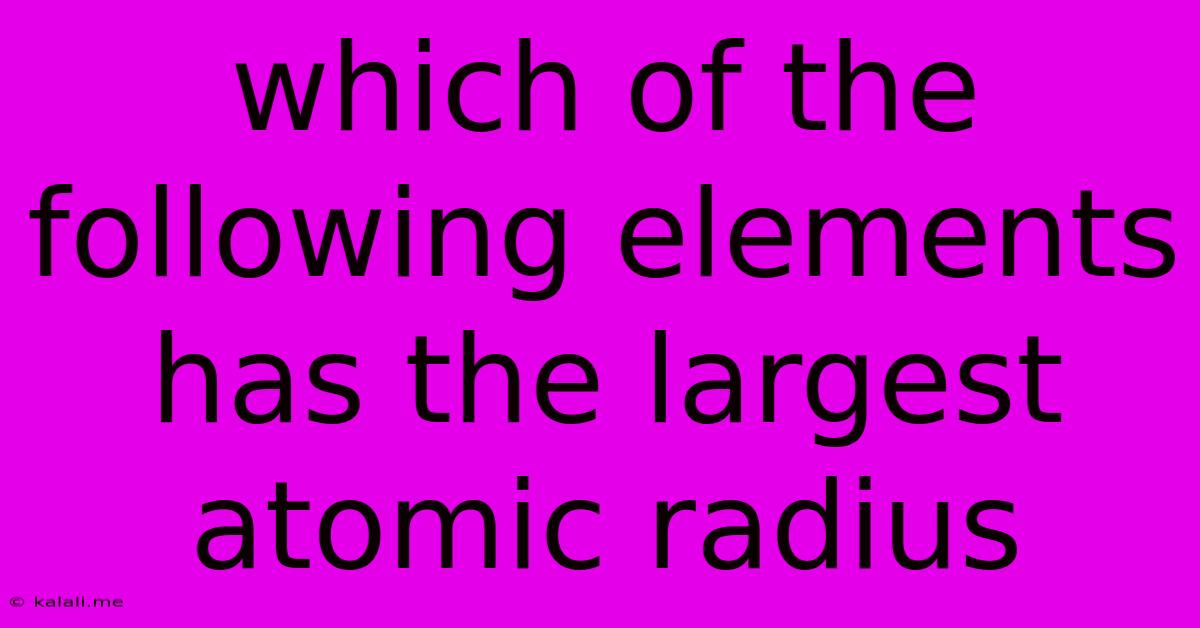Which Of The Following Elements Has The Largest Atomic Radius
Kalali
Jun 12, 2025 · 3 min read

Table of Contents
Which Element Boasts the Largest Atomic Radius? Understanding Atomic Size Trends
Determining which element possesses the largest atomic radius requires understanding the periodic trends that govern atomic size. This article will explore these trends and definitively answer the question, explaining the underlying principles in a clear and concise manner. We'll delve into the factors influencing atomic radius and why certain elements occupy the top spots in terms of size.
Understanding Atomic Radius
Atomic radius refers to the distance from the nucleus of an atom to its outermost electron shell. It's a crucial property influencing an element's chemical behavior and physical characteristics. Predicting relative atomic radii involves considering several key factors:
-
Effective Nuclear Charge: This represents the net positive charge experienced by the valence electrons. A higher effective nuclear charge pulls electrons closer to the nucleus, resulting in a smaller atomic radius. Shielding by inner electrons reduces the effective nuclear charge felt by outer electrons.
-
Principal Quantum Number (n): This number indicates the energy level of an electron. As the principal quantum number increases, the electron resides further from the nucleus, leading to a larger atomic radius.
-
Electron-Electron Repulsion: Electrons within the same shell repel each other. This repulsion can slightly counteract the attractive force of the nucleus, leading to a slightly larger atomic radius.
Periodic Trends in Atomic Radius
As we move across a period (from left to right) in the periodic table, the atomic radius generally decreases. This is because the effective nuclear charge increases while the principal quantum number remains constant. The added protons pull the electrons closer.
Conversely, as we move down a group (from top to bottom) in the periodic table, the atomic radius generally increases. This is primarily due to the addition of new electron shells (increasing the principal quantum number), which outweighs the increase in effective nuclear charge.
The Contenders for Largest Atomic Radius
While several elements in the lower periods boast large atomic radii, the element generally considered to have the largest atomic radius is Francium (Fr). This is due to its position at the bottom of Group 1 (alkali metals). Francium has a very high principal quantum number, placing its outermost electrons very far from the nucleus, despite a significant increase in nuclear charge. Cesium (Cs) is a close second, also belonging to Group 1.
Why not other elements?
While elements in the actinide series possess many electrons and might seem like contenders, their effective nuclear charge is surprisingly high due to relativistic effects and poor shielding. This makes their atomic radii smaller than expected compared to Francium and Cesium.
Conclusion
In conclusion, while the precise measurement of atomic radius can be challenging, Francium generally holds the title of the element with the largest atomic radius based on our current understanding of periodic trends and atomic structure. The interplay between effective nuclear charge, principal quantum number, and electron-electron repulsion ultimately determines an element's size. Understanding these fundamental principles allows us to predict and explain the observed trends in atomic radii across the periodic table.
Latest Posts
Latest Posts
-
Truth Table For 3 Input And Gate
Jun 13, 2025
-
The Study Of Universe Is Called
Jun 13, 2025
-
Fluid Part Of Blood After Removal Of Corpuscles Is
Jun 13, 2025
-
What Is The Molecular Mass Of Calcium Nitrate
Jun 13, 2025
-
What Do Dna Proteins And Fats Have In Common
Jun 13, 2025
Related Post
Thank you for visiting our website which covers about Which Of The Following Elements Has The Largest Atomic Radius . We hope the information provided has been useful to you. Feel free to contact us if you have any questions or need further assistance. See you next time and don't miss to bookmark.